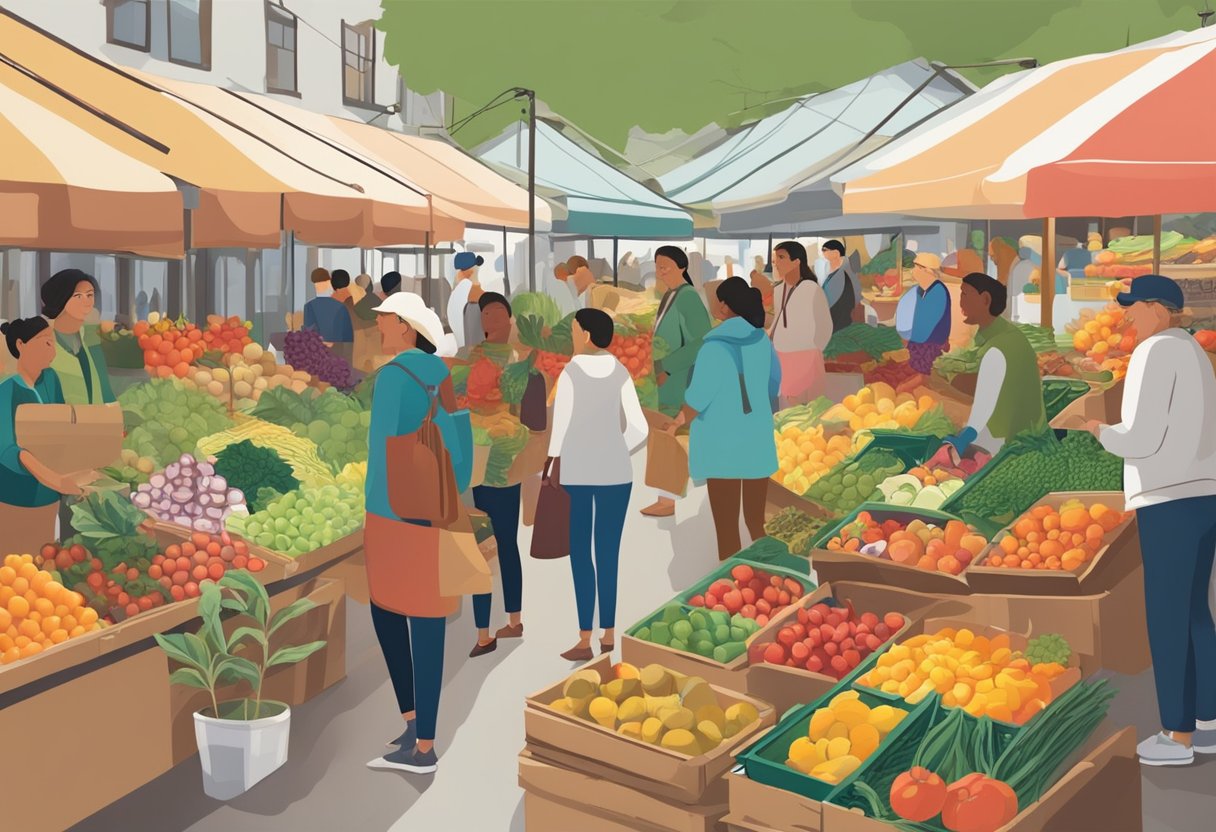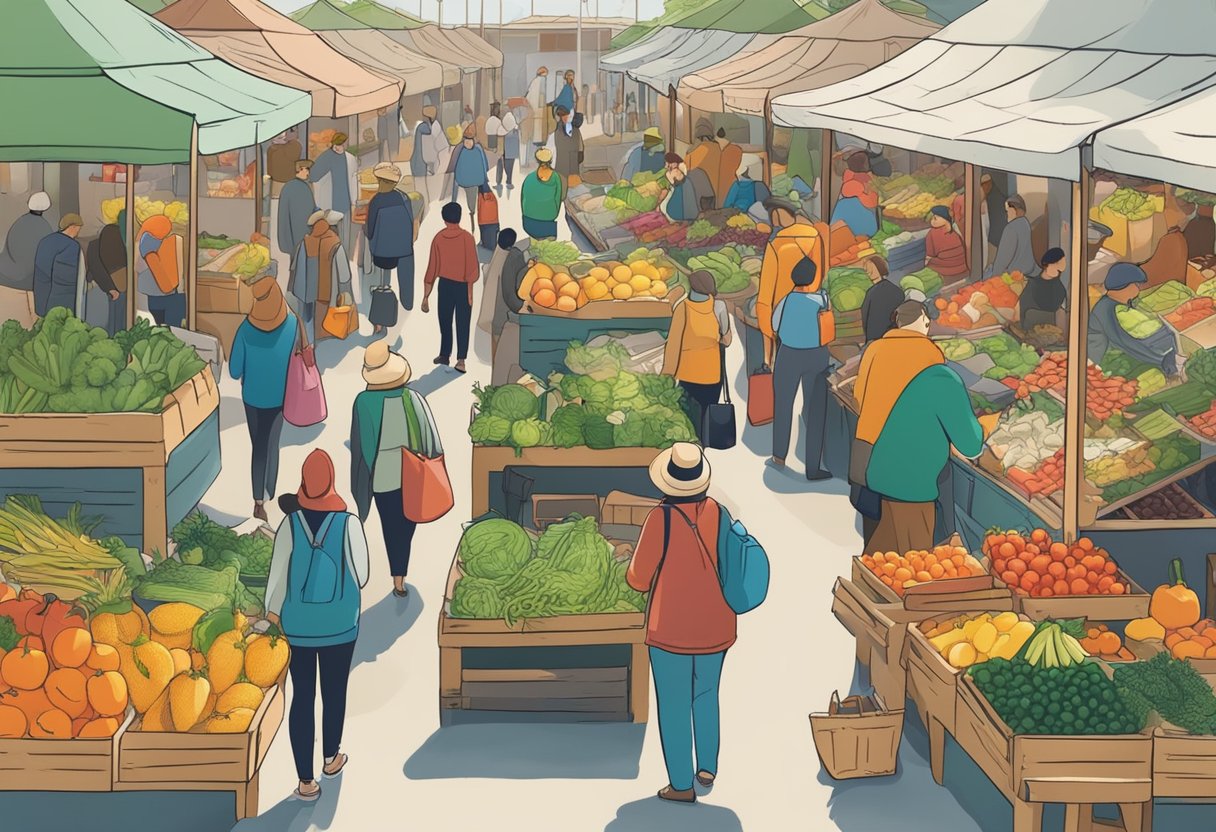Embracing a gluten-free Mediterranean diet often leads individuals to reconsider not just what they eat, but also where their food comes from. Local markets serve as treasure troves of fresh, seasonal produce, aligning perfectly with this dietary preference that emphasizes whole, unprocessed foods. By choosing to shop at these venues, consumers engage with a cycle of eating that is tuned to the natural production rhythms of their local environment. The merits of local and seasonal shopping are manifold, encompassing improved health benefits, a boost to the local economy, and a step toward a more sustainable world.

The tapestry of local markets extends beyond the aisles of fresh produce; it weaves into the broader context of consumers’ lives, affecting their shopping habits and, in turn, the local landscape. As demand for clean, gluten-free, and nutrition-rich foods grows, local markets adapt by offering a variety of fruits, vegetables, grains, and other products that suit the Mediterranean diet’s criteria. Attention to seasonal shopping habits not only ensures that one is getting foods at their peak flavor and nutrient profiles but also educates communities on the ecological and economic advantages of supporting local agriculture. Moreover, in a marketplace increasingly filled with imported goods, the act of purchasing from local farmers stands as a statement of promoting sustainability and reducing ecological footprints.
Key Takeaways
- Local markets offer alignment with a gluten-free Mediterranean diet through fresh, unprocessed foods.
- Seasonal shopping enhances health and educates communities on sustainable habits.
- Local and seasonal buying supports the environment and local economies.
Table of Contents
The Importance of Local Markets
Local markets play a crucial role in reinforcing the economic and social fabric of a community by fostering the exchange of goods and services on a more personal level. Their importance extends across various spheres of local life.
Boosting the Local Economy
When consumers opt to spend their money at local markets, they directly contribute to the local economy. Dollars spent at local businesses tend to stay within the community, bolstering the economic vitality of the area. This is partly due to the economic multiplier effect, where local spending generates more local spending. For example, when local restaurants source ingredients from nearby farms, this not only helps the farmers but also keeps the money circulating locally, which can lead to job creation and stronger economic resilience.
Supporting Local Farmers and Small Businesses
Local markets provide an essential platform for local farmers and small businesses to sell their products, often including a variety of gluten-free Mediterranean diet options. This support goes beyond just economic terms; it fosters a robust network of producers and consumers. Small businesses and farmers benefit from direct interaction with their customers, which can lead to lasting relationships and a loyal customer base. Additionally, these markets give small businesses a chance to showcase their unique offerings, such as locally-made art and handcrafted goods, which might struggle for visibility against larger chain stores.
Environmental Advantages of Local Shopping
Choosing to shop locally has a significantly positive environmental impact. Reduced transportation distances mean fewer carbon emissions, which is vital for sustainability. Local shopping usually involves less packaging and fresher produce, as goods do not have to be prepared for long-distance transportation. This promotes not only a healthier lifestyle in harmony with seasonal cycles but also decreases the ecological footprint of food consumption. Local markets often carry a selection of gluten-free staples that cater to specific dietary needs, emphasizing the importance of health and sustainability in their product offerings.
By recognizing the multifaceted benefits of local markets, communities can support a model of commerce that enriches both the local economy and the quality of life for its residents.
Health and Nutrition Benefits
Shopping at local markets for fresh produce provides significant health and nutrition advantages. Individuals who choose local and seasonal foods benefit from enhanced quality and a richer nutrient profile in their diet.
Fresher, More Nutritious Produce
Local markets typically offer fresh fruits and vegetables that have been harvested at their peak. This means they are more likely to retain their full content of vitamins, minerals, and antioxidants, essential for maintaining good health. For example, berries purchased in season often have higher levels of vitamin C and polyphenols compared to those that have been shipped long distances.
Reducing Chemical Intake
Local and organic foods are often grown without the use of synthetic pesticides and fertilizers. Consumers who prioritize these organic options may reduce their intake of potentially harmful chemicals, which can be beneficial for one’s health and especially important for those who follow a gluten-free Mediterranean diet, as it emphasizes the purity and quality of the food.
Dietary Diversity and Seasonal Foods
Integrating a variety of seasonal foods contributes to dietary diversity, aiding digestion and metabolism. Embracing fresh produce like vegetables, fruits, and organic foods throughout the seasons encourages a balanced diet rich in essential nutrients. Additionally, seasonal eating aligns with a Mediterranean diet’s focus on high-quality and diverse food sources.
Seasonal Shopping Insights

Seasonal shopping is not just about aligning with the cycles of nature—it also involves savoring the peak flavor of produce and embracing the variety it brings to our diets. The commitment to seasonal shopping can lead to more eco-friendly choices, as it reduces food miles and encourages sustainable agriculture practices.
Understanding Seasonal Produce Cycles
The cycles of seasonal produce are dictated by the natural growing seasons, ensuring that consumers can enjoy fruits and vegetables at their optimal taste and nutritional value. For example, purchasing tomatoes in the summer, when they are in season, usually means they are ripened on the vine and harvested at the peak of freshness, which can greatly enhance the flavor profile of gluten-free Mediterranean dishes.
- Spring: Offers fresh greens, herbs, and early root vegetables; a prime time for asparagus and artichokes.
- Summer: Bursting with berries, stone fruits, and tomatoes; ideal for Mediterranean salads and salsas.
- Fall: Brings an abundance of squash, apples, and root vegetables; suitable for hearty, gluten-free stews.
- Winter: Reserved for citrus, pomegranates, and hardy greens like kale; perfect for adding a fresh twist to winter meals.
Flavor Benefits and Preservation Methods
The flavor benefits of in-season produce are substantial. Fruits and vegetables consumed during their natural harvesting period have superior taste, which can transform the quality of a recipe. Furthermore, seasonal produce supports a gluten-free Mediterranean diet by providing fresh ingredients that are often at the center of these culinary traditions.
To preserve this quality year-round, methods such as freezing and blanching are effective. Freezing seasonal produce at its peak can retain much of its taste and nutritional content, enhancing the flavor of gluten-free dishes. Blanching vegetables before freezing helps in maintaining their color, texture, and nutritional value.
Impact on Food Variety and Innovation
Seasonal shopping encourages diversity in the kitchen. Having a rotating selection of produce inspires new recipes and techniques catering to a gluten-free Mediterranean diet. It motivates chefs and home cooks alike to explore creative ways of incorporating local food into their meals. This heightened food variety can spur innovation in the kitchen, leading to a compilation of recipes that highlight the unique aspects of each season’s produce.
- Spring: Gluten-free tabbouleh with quinoa and vibrant spring peas.
- Summer: Chilled gazpacho utilizing ripe summer tomatoes and cucumbers.
- Fall: Roasted butternut squash paired with gluten-free grains.
- Winter: Citrus salads with winter greens, complementing warm, gluten-free bread.
Seasonal shopping does not only benefit taste and variety but also conserves energy by reducing the need for extensive transportation, known as food miles, and storage of out-of-season produce. This practice aligns with the values of those on a gluten-free Mediterranean diet, offering fresh, flavorful ingredients that support health and sustainability.
Educating Communities on Local and Seasonal Shopping
Educating communities on the importance of local and seasonal shopping is vital for promoting sustainable agricultural practices and healthy eating habits. Utilizing Community-Supported Agriculture (CSA) programs and incorporating food education initiatives can significantly contribute to this goal.
Community-Supported Agriculture Programs
Community-Supported Agriculture programs are an excellent way for communities to engage directly with local farmers. By committing to purchase seasonal produce from these farms, individuals not only support the local economy but also gain access to fresh, nutrient-rich foods that are often harvested at their peak. CSA subscribers typically receive a share of the harvest throughout the farming season, which introduces them to a variety of produce and encourages a Mediterranean diet free from gluten-rich products.
- Elements of CSA:
- Direct support of local farmers
- Weekly or bi-monthly shares of produce
- Exposure to a variety of seasonal vegetables and fruits
Food Education in Schools and Community Gardens
Implementing strong food education in schools and involving children in community gardens are pivotal processes. These educational measures ensure that children understand where their food comes from and the benefits of consuming locally-sourced, seasonal foods. Moreover, embracing a gluten-free Mediterranean diet can be seamlessly integrated into this learning, highlighting how local produce can be used to create wholesome, gluten-free meals.
- Educational Benefits:
- Improved knowledge of food origins and seasonal cycles
- Hands-on experiences with planting, growing, and harvesting
- Promotion of healthy, gluten-free eating habits through practical examples
Shopping Strategies and Economic Considerations

When opting for local and seasonal shopping, consumers should evaluate the economic impact of their choices and the varying costs involved. This analysis of shopping strategies helps shoppers to weigh the benefits of local markets against supermarkets, while understanding the broader economic implications of their food sources.
Comparing Costs: Local Markets vs. Supermarkets
Local markets and farmers markets in places like California, Colorado, and Alabama offer a range of local produce that competes with supermarket prices. Cost considerations often show that buying directly from local markets can be more cost-effective, notably when the produce is in season. For instance, a study indicated that for every dollar spent at a local market, a larger portion stays in the local economy compared to dollars spent at supermarkets. In terms of a gluten-free Mediterranean diet, one can find high-quality, fresh ingredients at local markets often at comparable or cheaper prices than supermarkets, especially when taking into account weekly deals or bulk purchases.
| Item | Local Market (per lb) | Supermarket (per lb) |
|---|---|---|
| Gluten-free grains | $$ | $$$ |
| Seasonal vegetables | $ | $$ |
| Fresh herbs | $$ | $$$ |
Understanding the Real Costs of Imported Foods
The real costs of imported foods extend beyond just the price tag. Supermarkets often stock foods that have been transported over long distances, contributing to a higher carbon footprint. In contrast, local retailers in Arizona or California, for example, have a shorter distance to cover when transporting food, thereby reducing the associated carbon emissions. When it comes to a gluten-free Mediterranean diet, selecting local olive oils, nuts, and legumes can lessen the carbon footprint while ensuring the freshness of goods. It must be noted that online shopping for local foods is also emerging as a strategic way to reduce emissions, with the added convenience of home delivery. The real cost thus encompasses both the environmental impact and the economic implications for local communities.
Promoting Sustainability and Environmental Responsibility

Shopping at local markets and partaking in seasonal shopping habits offer substantial environmental benefits. By opting for products from small farms and community supported agriculture programs, consumers can effectively reduce their carbon footprint and promote sustainability.
Reducing Energy Consumption and Waste
Local and seasonal shopping tends to reduce energy consumption. Products sourced from regional producers mean that goods travel less distance to reach consumers, which directly reduces the energy expended in transportation. For example, local harvest items do not require long-haul freight, which is a major source of carbon emissions.
- Energy Savings: Shorter transportation distances for local produce mean less fuel used, which in turn lessens the carbon footprint.
- Waste Reduction: Smaller scale production often leads to less packaging and subsequently, less waste. Utilizing recycling efforts and community supported agriculture programs reinforces this reduction by encouraging minimal use of materials.
Advocating for Recycling and Reduced Plastic Use
A strong emphasis on recycling and the use of fewer plastics is integral to environmental responsibility. Local markets often lead the way in using biodegradable or reusable packaging, which greatly cuts down on the plastic entering landfills and polluting ecosystems.
- Recycling: Markets and community supported agriculture programs can promote the use of compostable materials and effective recycling to minimize waste.
- Plastic Reduction: Shifting to alternatives such as cloth bags or plant-based packaging during shopping reduces reliance on plastics, which are often derived from non-renewable resources and persist in the environment for centuries.
By encouraging these practices, local and seasonal shopping becomes a powerful advocate for environmental health, offering a clear path to a more sustainable and responsible lifestyle.
Product Highlights from Local Markets
Local markets are a treasure trove of fresh and nutritious produce straight from the farm. They showcase an array of quality items and regional specialties.
From Farm to Table: A Closer Look at Common Items
Local markets are especially valued for their fresh bread and meat, which are often sourced from nearby farms ensuring high quality and rich nutrition. Fresh tomatoes, fruits, and vegetables are picked at their peak, boasting a higher content of vitamins than those that travel long distances to reach supermarkets.
- Fruits: Seasonal picks like apples and bananas are market favorites.
- Vegetables: Look for asparagus in spring and leafy greens throughout the summer.
- Dairy: Fresh cheese from local dairies often features unique blends and flavors.
- Eggs: Free-range eggs come from chickens that have a better diet and environment, which many say contributes to the quality of the eggs they lay.
Specialty Products and Local Delicacies
Local markets also introduce shoppers to a variety of specialty items that are difficult to find elsewhere.
- Cheese: Artisanal cheeses, including gluten-free options, showcase the craftsmanship of local growers and dairies.
- Meat: Gluten-free Mediterranean diet adherents will appreciate the selection of grass-fed lamb and goat meat.
- Nuts: Freshly harvested nuts provide a healthful, protein-rich snack or ingredient for those on this diet.
This focus on regional produce supports not just the gluten-free Mediterranean lifestyle but also the farmers market ethos – shorter transportation, fewer preservatives, fostering community ties, and benefiting from the vendors’ expert knowledge.
Frequently Asked Questions

Exploring local markets offers a glimpse into the direct benefits and potential trade-offs of seasonal shopping, with considerations from environmental impacts to economic advantages.
What environmental impacts does consuming locally grown food have?
Consuming locally grown food typically reduces the carbon footprint associated with long-distance transportation. Local produce also tends to demand less packaging, thus reducing plastic use and processing emissions.
How does purchasing from local producers economically benefit the community?
Purchasing from local producers stimulates the local economy by keeping money within the community. It supports local farmers and businesses, aiding in the creation of jobs and fostering community development.
Can you list the advantages of choosing local and seasonal foods over imported ones?
Choosing local and seasonal foods supports biodiversity and ensures fresher produce on your plate. It often results in nutrient-rich foods, with less time from harvest to consumption, preserving the foods’ flavor and nutritional content.
What are some potential drawbacks of sourcing food from local markets?
A potential drawback is the limited variety, as local markets can only offer what’s in season. Shoppers may also encounter higher prices due to the scale of local production compared to larger, commercial operations.
How can shopping at local markets contribute to a stronger local economy?
By shopping at local markets, consumers directly support farmers and small businesses in their area. This can lead to economic resilience, community empowerment, and the reduction of poverty rates.
What are the main categories of the MyPlate nutritional guide, and how does local produce fit into this framework?
The main categories of the MyPlate nutritional guide include fruits, vegetables, grains, protein, and dairy. Local produce fits well into this framework by offering fresh fruits and vegetables that can fill half of the plate, as recommended for a balanced diet.



